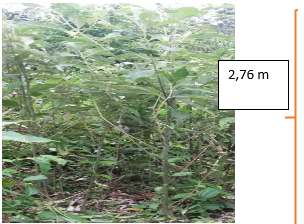Growth and conservation of Piptocoma discolor (Pigüe) in the Province of Pastaza - Ecuador
Main Article Content
Abstract
Downloads
Article Details
References
ACOSTA MIRELES, M., CARRILLO ANZURES, F., DELGADO, D. y VELASCO BAUTISTA, E., 2014. Establecimiento de parcelas permanentes para evaluar impactos del cambio climático en el Parque Nacional Izta-Popo. Revista mexicana de ciencias forestales [en línea], vol. 5, no. 26, pp. 06-29. [Consulta: 21 septiembre 2018]. ISSN 2007-1132. Disponible en: http://www.scielo.org.mx/scielo.php?script=sci_abstract&pid=S2007-11322014000600002&lng=es&nrm=iso&tlng=es.
AGUIRRE MENDOZA, Z. y LEÓN, N.A., 2009. Conocimiento inicial de la fenología y germinación de diez especies forestales nativas en El Padmi, Zamora Chinchipe. revista CEDAMAZ (Centro de Estudios y desarrollo de la amazonia y docente Investigador de la Universidad Nacional de Loja) [en línea], pp. 1-6. Disponible en: http://unl.edu.ec/sites/default/files/investigacion/revistas/2014-9-5/8_articulo_de_investigacion_-_63_-_72_c2.pdf.
AKCA, A., 1993. Forrest inventory. Alemania: Institut for Forsteinrichtung and Ertragskunde. Universidad de Gottingen.
CAMACHO, P. y MURILLO, O., 1997. Metodologia para la evaluacion de la calidad de plantaciones forestales recien establecidas. Agronomia Costarricense [en línea], vol. 21, no. 2, pp. 189-206. Disponible en: http://www.mag.go.cr/rev_agr/v21n02_189.pdf.
CANCINO, C. y O, J., 2012. Dendrometría básica [en línea]. S.l.: Universidad de Concepción. Facultad de Ciencias Forestales. Departamento Manejo de Bosques y Medio Ambiente. [Consulta: 21 septiembre 2018]. ISBN 978-956-8029-67-8. Disponible en: http://repositorio.udec.cl/handle/11594/407.
ERAZO, G., IZURIETA, J.C., CRONKLETON, P., LARSON, A.M. y PUTZEL, L., 2014. El uso de pigüe (Piptocoma discolor) por los pequeños productores de Napo, Ecuador: Manejo sostenible de una especie pionera de madera para los medios de vida locales. [en línea], [Consulta: 29 agosto 2018]. DOI https://doi.org/10.17528/cifor/004424. Disponible en: https://cgspace.cgiar.org/handle/10568/93755.
HERNÁNDEZ BENALCÁZAR, H., GAGNON, D. y DAVIDSON, R., 2015. Crecimiento y producción inicial de 15 especies de árboles tropicales de la Amazonía ecuatoriana de estados sucesionales diferentes. Quito: UCE [en línea], pp. 1-7. [Consulta: 30 agosto 2018]. ISSN 1390 - 8928. Disponible en: http://www.dspace.uce.edu.ec/handle/25000/5149.
IMAÑA, J. y ENCINAS, O., 2008. Epídometria Forestal [en línea]. Brazilia, Brasil: Universidade de Brasilia, Departamento de Engenharia Florestal. ISBN 978-85-87599-31-5. Disponible en: http://repositorio.unb.br/bitstream/10482/9740/1/LIVRO_EpidometriaForestal.pdf.
INAMHI, 2015. Instituto Nacional de Meteorología e Hidrología – Ecuador. [en línea]. [Consulta: 30 agosto 2018]. Disponible en: http://www.serviciometeorologico.gob.ec/.
LUCAS HERGUEDAS, A.I., DEL PESO TARANCO, C., RODRÍGUEZ GARCÍA, E. y PRIETO
PANIAGUA, P., 2012. Biomasa, combustibles y sostenibilidad [en línea]. S.l.: Centro Tecnológico Agrario y Agroalimentario. ITAGRA.CT. [Consulta: 26 noviembre 2017]. ISBN 978-84-931891-5-0. Disponible en: http://sostenible.palencia.uva.es/system/files/publicaciones/Biomasa%2C%20Biocombustibles%20y%20Sostenibilidad.pdf.
MAE, 2014. Plan Nacional de Restauración Forestal. [en línea]. Quito, Ecuador: Ministerio del Ambiente del Ecuador. Disponible en: http://sociobosque.ambiente.gob.ec/files/images/articulos/archivos/amrPlanRF.pdf.
MERA, G.A., 2015. Mapa de la cobertura vegetal del cantón Mera. 2015. S.l.: Autor.
MERINO CASTILLO, J.P., 2011. Estudio Económico de dos formas de aprovechamiento forestal del pigue (pollalesta discolor) en el cantón Mera, provincia de Pastaza [en línea]. Tesis Ingeniero Forestal. Ecuador, Quito: Repositorio Institucional de la Escuela Superior Politécnica de Chimborazo. [Consulta: 21 septiembre 2018]. Disponible en: http://dspace.espoch.edu.ec/handle/123456789/749.
MÉXICO, C. D. ESTADOS UNIDOS MEXICANOS: SECRETARIA GENERAL DE SERVICIOS PARLAMENTARIOS, 2015. Ley General de Desarrollo Forestal Sustentable [en línea]. 26 marzo 2015. S.l.: s.n. [Consulta: 22 febrero 2018]. Disponible en: http://www.fao.org/faolex/results/details/es/c/LEX-FAOC036056/.
RODRÍGUEZ LAGUNA, R., 2009. GUÍA DE DENSIDAD PARA Pinus montezumae EN SU ÁREA DE DISTRIBUCIÓN NATURAL EN EL ESTADO DE HIDALGO. UNIVERSIDAD AUTÓNOMA DEL ESTADO DE HIDALGO. ÁREA ACADÉMICA DE INGENIERÍA FORESTAL [en línea], pp. 17. [Consulta: 21 septiembre 2018]. Disponible en: https://www.uaeh.edu.mx/investigacion/icap/LI_IntGenAmb/Rodri_Laguna/1.pdf.
ROMAHN CARLOS, F., R.H., 1973. Dendrometría. México: Universidad Autónoma de Chapingo División de Ciencias Forestales.
SAJDAK, M. y VELAZQUEZ-MARTI, B., 2012. Estimation of pruned biomass form dendrometric parameters on urban forests: Case study of Sophora japonica. Renewable Energy [en línea], vol. 47, pp. 188-193. [Consulta: 30 agosto 2018]. ISSN 0960-1481. DOI 10.1016/j.renene.2012.04.002. Disponible en: https://www.sciencedirect.com/science/article/pii/S0960148112002388.
SANTILLÁN PÉREZ, J., 1986. Elementos de dasonomía [en línea]. México: Chapingo, Méx.: División de Ciencias Forestales. Disponible en: http://www.sidalc.net/cgi-bin/wxis.exe/?IsisScript=bosque.xis&method=post&formato=2&cantidad=1&expresion=mfn=005313.
SPITLER, P., 1995. Guía técnica para el inventario rápido de bosques secundarios en la zona norte de Costa Rica. Costa Rica: COSEFORMO.
VALLEJO, 1982. Estudio de la factibilidad económica especie forestal del Pigüe. Ecuador: Hacienda en Pastaza.


